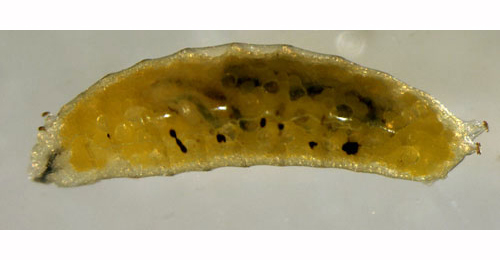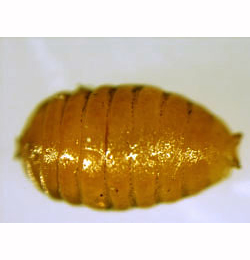|
||||||
|
Liriomyza
taraxaci Hering, 1927 Liriomyza
taraxaci Hering, 1927c. Z. angew. Ent. 13: 184 |
|||||||||||||||||||||||||||||||||||||||||||||||||||||||||||||||||||||||||||||||||||||||||||||
|
Leaf-miner: A small somewhat irregular, elongate blotch (Spencer, 1972b: 57; Spencer, 1976: 273 (fig. 491), 274). Elongated upper-surfcace blotch with fairly little frass in loose grains. Pupation outside the mine; exit slit in upper epidermis (Bladmineerders van Europa). Larva: The larvae of flies are leg-less maggots without a head capsule (see examples). They never have thoracic or abdominal legs. They do not have chewing mouthparts, although they do have a characteristic cephalo-pharyngeal skeleton (see examples), usually visible internally through the body wall. The larva is described by de Meijere (1925). Posterior spiracles each with an ellipse of 8-10 bulbs (Spencer, 1972b: 57; Spencer, 1976: 274). The larva is illustrated in Bladmineerders van Europa.
Puparium: The puparia of flies are formed within the hardened last larval skin or puparium and as a result sheaths enclosing head appendages, wings and legs are not visible externally (see examples). The puparium is illustrated in Bladmineerders van Europa.
Comments: Leontodon autumnalis is treated as Scorzoneroides autumnalis (Autumn Hawkbit) by Stace (2010). Hosts in Great Britain and Ireland:
Hosts elsewhere:
Time of year - mines: June-August. Time of year - adults: Currently unknown. Distribution in Great Britain and Ireland: Widespread in Britain including Perth (Killin) (Spencer, 1972b: 57), Warwickshire (Coventry, Holbrooks) (Robbins, 1991: 123); South-west Yorkshire and Surrey (NBN Atlas). Also recorded in the Republic of Ireland: Co. Kilkenny (Spencer, 1972b: 57). Distribution elsewhere: Widespread in Europe including Denmark, Sweden, Norway (Spencer, 1976: 274); The Netherlands, Luxembourg (Bladmineerders van Europa), Belgium (de Bruyn and von Tschirnhaus, 1991), Germany (Spencer, 1976: 562), Canary Is., Finland, French mainland, Lithuania, Poland and Spanish mainland (Fauna Europaea). Range extending eastwards to the Central Asian Republics of the [former] U.S.S.R. (Spencer, 1976: 274). Also recorded in Canada (Spencer, 1969a: 188). NBN Atlas links to known host species:
British and Irish Parasitoids in Britain and elsewhere:
|
|
|
|
| External links: | Search the internet: |
| Biodiversity Heritage Library Bladmineerders van Europa British leafminers Encyclopedia of Life Fauna Europaea NBN Atlas NHM UK Checklist |
Find
using Google Find using Google Scholar Find images using Google |
| Last updated 09-Jul-2019 Brian Pitkin | ||


